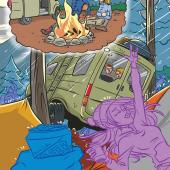Disinclined to Drift
The effort makes the catch
Anyone who spends time during summer and fall below Holter Lake on the Missouri becomes intimately familiar with one of the most prolific hatches on the storied water: not baetis or caddis, but daily swarms of drift boats launching beneath the dam and floating in convoys toward Craig. They can blanket that entire ten-mile stretch, with boats so close together you wonder how anglers avoid hooking adjacent passengers on back casts.
With our enviable access to outstanding rivers and locally made RO drift boats, fly-fishing vessels are everywhere—parked in driveways and along roadways, rattling behind shiny new Chevys and ancient Fords, bobbing down the blue-ribbon streams cutting through southwest Montana. Fly fishing shows bring vivid global fishing destinations life in your living room, featuring hosts landing trophy trout from a ClackaCraft or Hyde. Many anglers fish exclusively from the wooden or fiberglass confines of a drift boat… at least it seems that way.
My experience couldn’t be more different. I’ve never floated and fished at the same time. At first, ambulatory angling was a product of circumstance. My father preferred a small creek only a half-hour from home. Our earliest trips began by driving to a developed access site and claiming the nearest fishable water. Dad would position me along the bank, tell me to stay put, and proceed to cast. Only when he managed to hook a fish was I allowed to wade out, hold the rod, and turn the reel.
Despite his best efforts, I have few memories of actually catching fish on those early excursions. In my young mind, our lack of success was easy to explain: we were too close to the car. Even as a novice angler, I knew the fishing would be better above the next bend, even better the bend after that, and unbelievable the bend after that. We just needed to move. Youthful exhortations notwithstanding, my dad was skeptical about trekking any distance from our vehicle given my propensity to tire of watching him not catch fish and demand we leave. Few things are glummer than an angler trudging back to the car after a poor day of fishing. An angler trudging back to the car after a poor day of fishing while dragging a whiny nine-year-old is one of those things.
As I grew, my dad started leading us increasingly far from our starting point. And, go figure, we caught more trout. This reinforced my longstanding suspicions about fishing near the car, leading me to a simple axiom shared by many anglers: quality of fishing is directly proportional to your distance from the nearest parking area. Experience only strengthened that belief. My best memories of early trips inevitably involve arriving back at the sedan, sunburned and dangerously dehydrated, but basking in the glow of a successful day on the water miles from where we’d parked.
Logically speaking, a drift boat makes it easy to put space between yourself and your vehicle. While this is true, my early experiences slogging long distances in wading boots spawned a corollary that remains ingrained within me today: good fishing demands exhausting effort. Sitting in a boat, even if you’re handling the oars, simply cannot fulfill that condition, at least according to the fishing-focused portion of my brain.
I’d be lying if I said that I don’t wonder what it would be like to fish from a drift boat. I imagine myself and a few buddies—one of them manning the oars of course—gliding down the Yellowstone or Madison on a calm, 75-degree day. We’d lounge in the sun, drifting between prime stretches and enjoying a beer or four over the course of the afternoon. But despite the fleeting curiosity, I remain exclusively a wading angler.
Someday, I’ll undoubtedly float fish, and there’s a very good chance I’ll fall in love. But for now, while my legs are in decent shape and my mind remains firmly committed to my first axiom and corollary of fly fishing, I’ll continue driving to my favorite waters, parking the car, gearing up, and making that always-important decision afforded only to those who wade: downstream or upstream.












